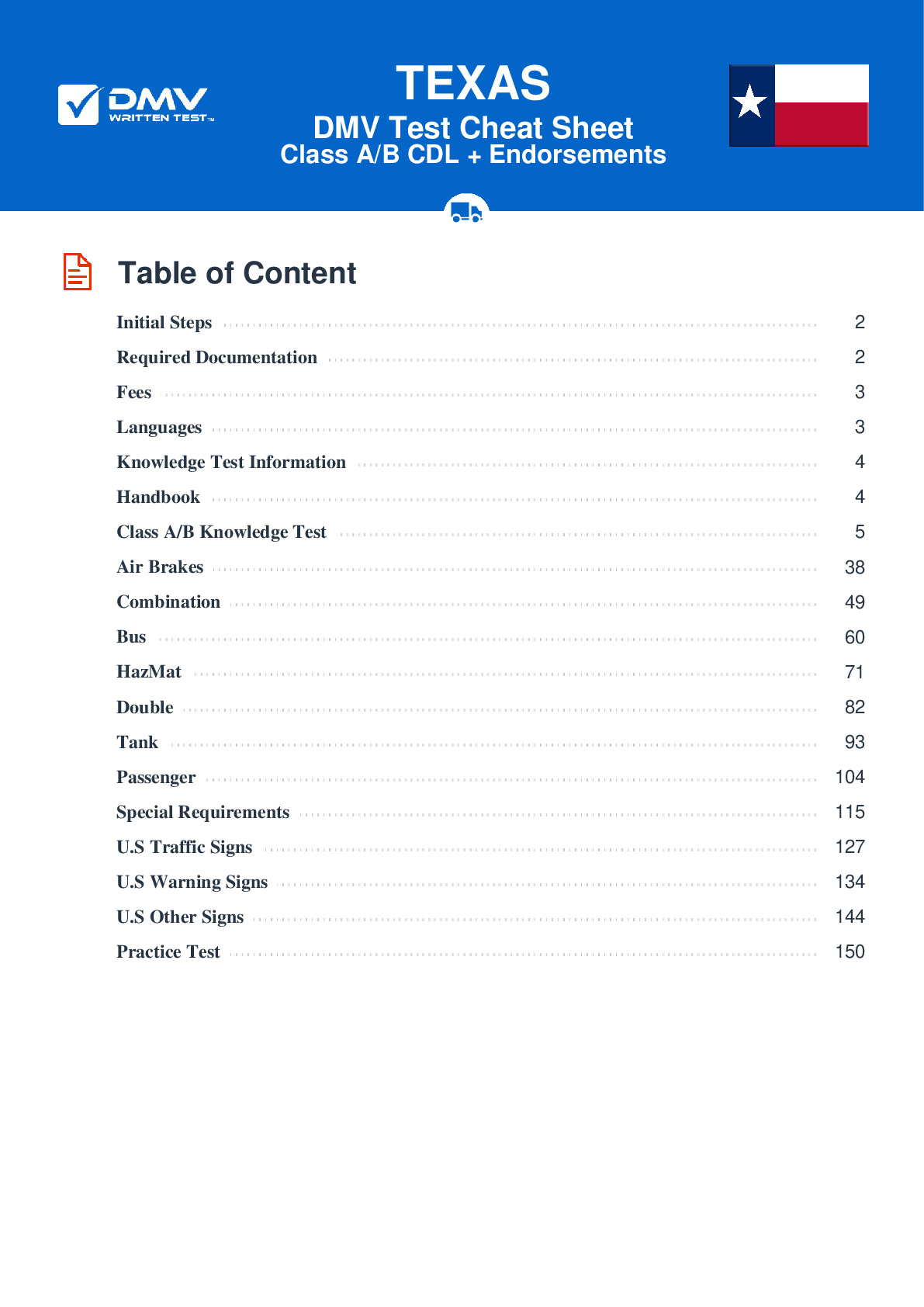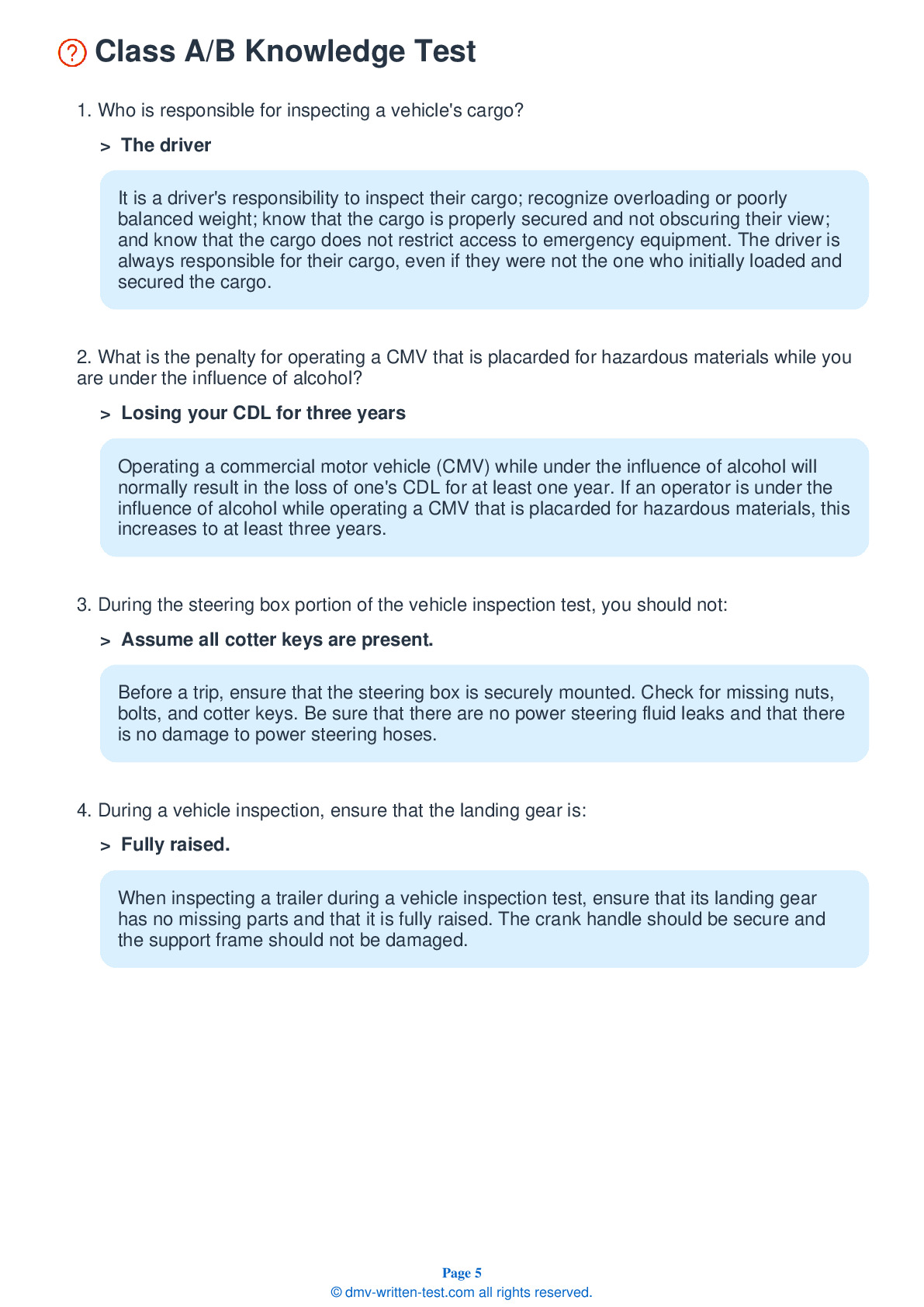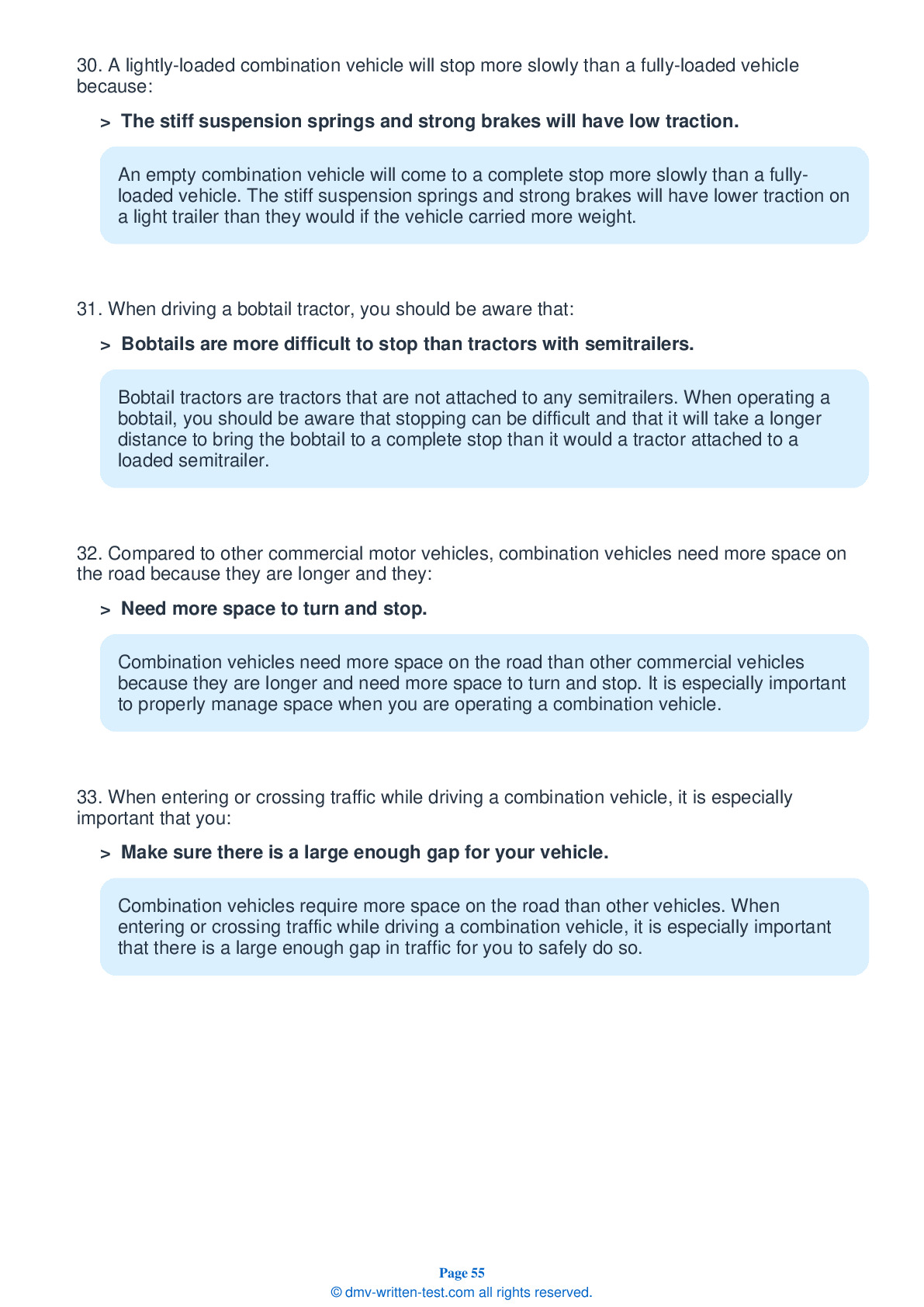Knowledge Test Class A
This license is required for driving any legal combination of vehicles,with a gross combination weight rating of 26,001 pounds or more, provided the GVWR of a trailer exceeds 10,000 pounds. To receive this license, applicants must pass a 70-question test. Test questions come from the Texas Commercial Motor Vehicle Drivers Handbook. Each question has four answer choices. To pass, applicants must answer 56 questions correctly. Test questions come from the Texas Commercial Motor Vehicle Drivers Handbook. Questions come from chapters covering: Introduction, Driving Safely, Transporting Cargo Safely, Air Brakes (if applicable), Combination Vehicles, Pre-Trip Vehicle Inspection Test, Basic Vehicle Control Skills Test and On-Road Driving. Endorsemetns that may be used with a Class A CDL are: Hazardous materials, Tank, Passenger, Doubles/Triples, HazMat and Tank, Air Brakes and School bus.
15. When inspecting the exhaust system, which of the following should not cause concern?
When inspecting a vehicle's exhaust system, be alert to a number of potential problems, including loose, broken, or missing exhaust pipes, mufflers, tailpipes, or vertical stacks; loose, broken, or missing mounting brackets, clamps, bolts, or nuts; exhaust system parts rubbing against fuel system parts, tires, or other moving parts of the vehicle; and exhaust system parts that are leaking.
16. You will lose your CDL for at least ____ for a first railroad-highway grade crossing violation.
A first-time offense for a railroad-highway grade crossing violation will result in the loss of one's CDL for at least 60 days.
17. How much water is needed on a road surface for a vehicle to hydroplane?
Hydroplaning is an effect in which a vehicle's tires lose traction with the surface of the road and instead glide along a layer of water. There does not have to be much water on the road for this to occur.
18. When starting the vehicle during the pre-trip inspection, the coolant temperature should:
After starting your vehicle during the pre-trip inspection, you should watch the gauges. The coolant temperature should gradually rise to a normal operating range.
19. If you are being tailgated, you should:
If someone is tailgating you, it is a good idea to open up the space ahead of your vehicle to make it easier for the driver to pass you. Increasing your speed is not a good idea because the driver may continue to tailgate you at the higher speed, only increasing the danger.
20. To correct a drive-wheel braking skid, a driver should do all of the following, except:
To correct a drive-wheel braking skid, you should first remove your foot from the brake pedal to allow the locked wheels to begin rolling again. Quickly steer in the direction you want to go, then countersteer to prevent your vehicle from skidding in the opposite direction.
21. When driving a vehicle equipped with an Anti-Lock Braking System (ABS), you should:
When driving a tractor-trailer combination that is equipped with an Anti-Lock Braking System (ABS), you should brake in the same manner that you would if the vehicle was not equipped with ABS.
Frequently Asked Questions
To obtain a Class A CDL in Texas, drivers must first pass a written knowledge test and then a skills test. They must also meet certain medical and physical requirements and provide documentation of their driving history. Once they pass these tests and meet the requirements, they can apply for a Class A CDL license through the Texas Department of Public Safety.
1. Tractor-trailers: A combination of a tractor unit and one or more semi-trailers.
2. Double and triple trailers: A combination of two or three trailers connected to a single tractor unit.
3. Tanker vehicles: Vehicles designed to transport liquids or gases in bulk.
4. Livestock carriers: Vehicles designed to transport live animals.
5. Flatbed trucks: Trucks with an open cargo area that is typically used for transporting large items such as building materials and heavy equipment.
It's important to note that drivers with a Class A CDL license may also be required to obtain additional endorsements if they plan on operating vehicles that require specialized knowledge and skills, such as hazardous materials (Hazmat) or passenger vehicles.
1. Be at least 18 years old: You must be at least 18 years old to drive intrastate (within Texas) and at least 21 years old to drive interstate (across state lines).
2. Hold a valid driver's license: You must have a valid driver's license in the state of Texas.
3. Pass a medical exam: You must pass a medical exam and provide a medical examiner's certificate that shows you meet the federal medical requirements for commercial drivers.
4. Pass a written knowledge test: You must pass a written knowledge test that covers general commercial driving topics and specific knowledge related to operating Class A vehicles.
5. Obtain a learner's permit: You must obtain a Class A CDL learner's permit before you can take the skills test.
6. Practice driving with a qualified CDL holder: You must practice driving with a qualified CDL holder who has held their license for at least one year in the same class of vehicle you are seeking to operate.
7. Pass a skills test: You must pass a skills test that includes a pre-trip inspection, basic vehicle control, and on-road driving.
After meeting these requirements, you can apply for your Class A CDL license through the Texas Department of Public Safety.
1. H (Hazardous materials): This endorsement is required if you plan on transporting materials that are considered hazardous by the Department of Transportation.
2. N (Tanker): This endorsement is required if you plan on transporting liquids or gases in bulk containers that are over 119 gallons.
3. P (Passenger): This endorsement is required if you plan on driving a vehicle designed to transport 16 or more passengers, including the driver.
4. T (Double/triple trailers): This endorsement is required if you plan on driving a combination of two or three trailers.
To obtain any of these endorsements, you must pass an additional knowledge test that covers the specific requirements for each endorsement. Additionally, some endorsements may require additional background checks or fingerprinting. It's important to check with your state's Department of Motor Vehicles to determine which endorsements are required for your specific driving situation.
1. Pre-trip inspection: This is a thorough inspection of the vehicle that you will be driving. You will need to show that you can identify and explain the function of various parts of the vehicle, check for any defects or safety issues, and ensure that the vehicle is safe to drive.
2. Basic controls: In this part, you will demonstrate your ability to control the vehicle in a controlled environment. You will be asked to perform maneuvers such as straight-line backing, offset backing, and parallel parking.
3. Road test: In this part, you will demonstrate your ability to drive the vehicle safely on public roads. You will need to show that you can follow traffic laws, make turns safely, change lanes, and negotiate intersections.
The entire skills test must be completed in a vehicle that matches the type of commercial vehicle you plan to operate. This means if you plan to operate a truck with air brakes, you must complete the skills test in a truck with air brakes.
It's important to note that the skills test is only one part of obtaining a Class A CDL license. You must also pass a written knowledge test and meet other state requirements before you can be issued a CDL license.
1. Air brake restriction: This restriction is placed on drivers who have not passed the air brake knowledge test or who did not complete the skills test in a vehicle with air brakes. Drivers with this restriction are not allowed to operate vehicles with air brakes.
2. L (No air brake equipped CMV): This restriction is placed on drivers who take the CDL skills test in a vehicle without air brakes. This means that the driver is only qualified to operate commercial vehicles without air brakes.
3. E (No manual transmission equipped CMV): This restriction is placed on drivers who take the CDL skills test in a vehicle with an automatic transmission. This means that the driver is only qualified to operate commercial vehicles with automatic transmissions.
4. K (Intrastate only): This restriction is placed on drivers who only plan to operate commercial vehicles within their state of residence.
5. P (Passenger vehicle): This restriction is placed on drivers who only plan to operate vehicles designed to transport passengers, such as buses or vans.
It's important to note that these restrictions/limitations may vary by state, and some states may impose additional restrictions beyond those listed above. Drivers should check with their state's Department of Motor Vehicles to determine what restrictions/limitations apply to their specific situation.
If the test is not available in your preferred language, you may be able to bring an interpreter with you to the testing center. However, the interpreter must be approved by the testing center and must not be a family member or friend. The interpreter must also sign a statement agreeing to maintain confidentiality and impartiality during the testing process.
It's also important to note that even if you take the written test in a language other than English, you will still need to demonstrate your ability to read and understand English for the CDL skills test and for operating a commercial vehicle on public roads.
To request accommodations, you will need to provide documentation of your disability and how it impacts your ability to take the test. This documentation may include a note from your doctor or a letter from a qualified professional who has evaluated your disability.
It's important to note that the process for requesting accommodations may vary by state. You should contact your state's Department of Motor Vehicles for more information on how to request accommodations for the Class A CDL written test.
If you fail the test multiple times, there may be additional waiting periods before you can retake it again. It's important to note that you may be required to pay a fee each time you retake the test.
It's also important to use your time wisely between attempts. Review the areas where you struggled and study the materials provided by your state's Department of Motor Vehicles. You may also want to consider taking a CDL practice test to help identify areas where you need additional study.
Remember, passing the written test is just one step in obtaining a Class A CDL. You will also need to pass a skills test and meet other requirements, such as providing a valid medical certificate and passing a background check.




